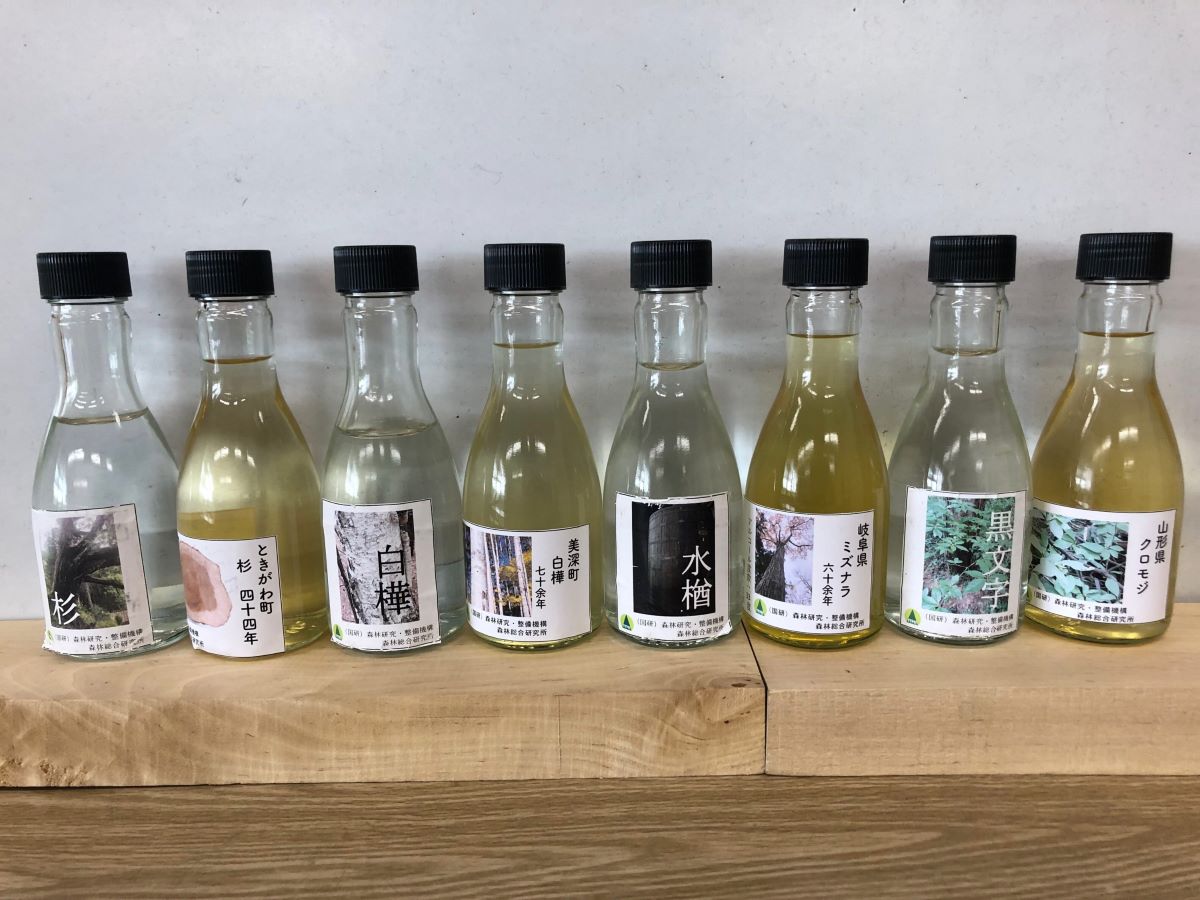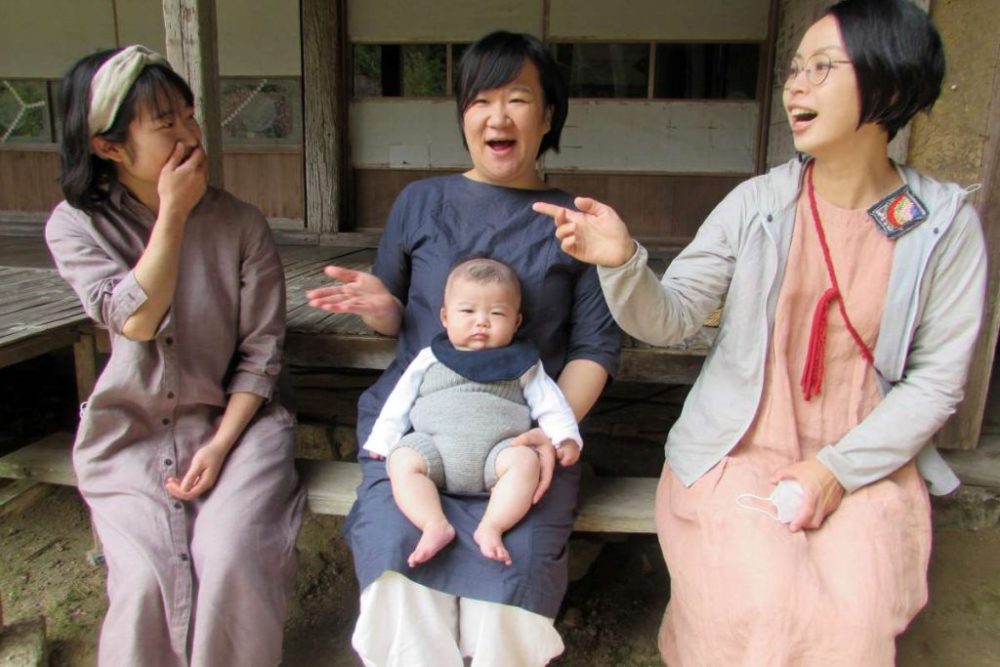Wood Liquor: Growth Rings Transform Into a Promising New Business
For the first time, wood from 100-year-old trees can be made into wood liquor, a new beverage that could be key to revitalizing forestry and mountain villages.

このページを 日本語 で読む
The history of spirits dates back to 13,000 years ago, and today, it welcomes a new page. This new liquor is not made from fruits, like wine, or cereals, like sake. Its main ingredient, while familiar, has never before been used to make liquor. That ingredient is aged trees from forests. And wood liquor is made from fermenting that wood.
Researchers at the Forestry and Forest Products Research Institute (FFPRI) in Tsukuba (Ibaraki Prefecture) spent six years experimenting and now they have a product ready to sample.
They have produced four varieties from the wood of Japanese cedar, white birch, mizunara (a type of Mongolian oak), and the kuromoji tree (a type of spicebush). Each species of tree has a distinct fragrance and flavor profile. Close your eyes and take a sip, and it feels as though you can hear treetops rustling in the breeze.
Mellow Fragrance and Flavor
The development of wood liquor has no precedent anywhere in the world. A paper on its development was published in 2020 in a journal of the UK-based Royal Society of Chemistry.
The research team found no issues in all varieties based on continued safety testing. This author had a chance to participate in a trial tasting of the fragrance and flavor profiles of this new liquor.
I first took in the fragrance before taking a sip and allowing the liquid to enter my throat as I swallowed.
The cedar liquor gives off the feeling of conifer trees, while the birch has a subtle sweetness. The oak has a similar profile to whiskey. All evoke elements of the trees from which they are made. The spicebush, also used for high-end toothpicks, produced a hearty liquor with a distinct character.
Like 'Drinking Time'
"If I had to describe the wood liquor in just a few words, I’d say it’s like drinking time," says Dr Yuichiro Otsuka, senior researcher at FFPRI.

Throughout their over 100 years of life, from the time they are saplings to when they are felled, the old trees accumulate glucose as cellulose in their growth rings. That glucose becomes alcohol when fermented.
The glucose is nothing more than the assimilation of carbon dioxide from the air and water absorbed from the roots by the tree's photosynthesis over a century.
Unlike vintage wine, whose value increases in the years after fermentation, wood liquor is "vintage" from the moment it is made, thanks to the tree’s age.
"Time-wise, this puts wood liquor in a completely different category from all the other alcoholic beverages produced to date," Dr Otsuka adds.
Feeling an Affinity for History
Dr Otsuka also suggests "communing with history through wood liquor."
Cedar trees have been planted in the Yoshino district of Nara Prefecture since the Edo period, and some are over 200 years old. Trees were planted around the time of the Meiji Restoration of 1868 remain.
Wood liquor made from these trees could rightly be named "Yoshino Cedar Spirit of the Restoration".
It is not simply about feeling the passing of time. The carbon steeped into each growth ring, from the end of the shogunate to the current Reiwa era, becomes part of the body of the person who drinks it.
Perhaps that person will feel an affinity for historical figures of the time, like Sakamoto Ryoma or Saigo Takamori.
Using Nanotechnology
But just how is this alluring liquor made?
The walls of the individual cells that make up wood contain cellulose, to which glucose is attached in a chain-like state. However, these cell walls are lignified (made into wood) by a polymer called lignin and are extremely hard.

The first step in production is adding water to wood that was pulverized into a powder by machine. It then gets a good stir together with ceramic beads used in nanotechnology. This process is called wet-type bead milling (WBM). The wood powder changes into fine particles thinner than the cell walls, freeing the cellulose from the lignin.
Then, the cellulose is turned into glucose using an enzyme. Yeast then triggers alcoholic fermentation, creating wood liquor. A vacuum distillation method is then applied to make distilled wood liquor.
A 10 cm-thick, 35 cm-long board of cedar thus transforms into 750 ml of distilled liquor with a 35% alcohol content.
Sleeping Beauty
Something about wood liquor is reminiscent of the European fairytale, Sleeping Beauty.
With a wicked witch's curse, a young princess falls into a deep sleep inside the tower of an unapproachable castle. One hundred years later, a prince from a neighboring country decides to save her. When he approaches the castle in the forest with his sword unsheathed, the overgrown brambles part before him. The story ends with a lifting of the curse when the princess awakens.
Last month, new varieties joined the lineup of wood liquors. While the earlier wood liquors had a mellow fragrance, they also had a harsh aftertaste. The team added some extra steps to the distillation process and were able to find a way to keep the flavor while making the taste more palatable.
Revitalizing Mountain Villages
Despite receiving many inquiries about their technique from overseas, the team has politely declined them all. They are operating on the conviction that the first wood liquor product in the world must be made in Japan from Japanese wood.
FFPRI has devoted itself to perfecting the technology, but will not enter into business. Rather, it expects domestic distilleries to take up the effort. The Ethical Spirits & Co., a distillery venture company based in Tokyo's Taito Ward, is trying to respond to those expectations.
Dr Otsuka envisions the creation of a new business in wood liquor that will stimulate demand for domestic wood, spur growth in the forestry industry, and revitalize mountain villages. It would also create a new use for large trees that have grown too big and scrap wood from forest thinning.
An experimental facility for the production of wood liquor is now under construction. Its completion will enable more efficient research and diversification of the types of wood used.
Added-value spirits of differing profiles according to their area of origin will be born out of the combination of Japanese forests and water.
このページを 日本語 で読む










